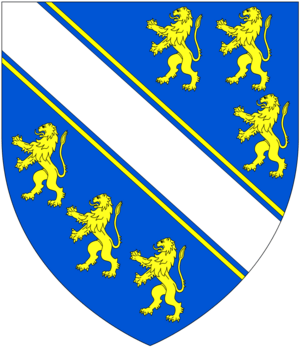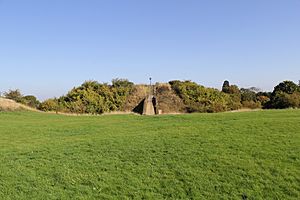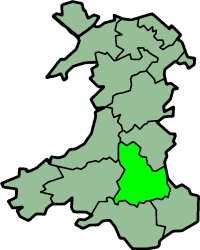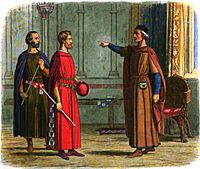Humphrey de Bohun, 3rd Earl of Hereford facts for kids
Quick facts for kids
Humphrey de Bohun
|
|
|---|---|
| 3rd Earl of Hereford | |

Arms of Bohun: Azure, a bend argent cotised or between six lions rampant of the last
|
|
| Tenure | 1270–1298 |
| Predecessor | Humphrey de Bohun, 2nd Earl of Hereford |
| Other titles | 2nd Earl of Essex |
| Known for | Opposition to Edward I |
| Years active | 1260s–1298 |
| Born | c. 1249 |
| Died | 31 December 1298 Pleshey, Essex, England |
| Buried | Walden Priory 52°01′34″N 0°14′42″E / 52.0262°N 0.2449°E |
| Nationality | English |
| Residence | Pleshey Castle |
| Locality | Essex, Wiltshire, Welsh Marches |
| Wars and battles | Welsh Wars |
| Offices | Constable of England |
| Spouse(s) | Maud de Fiennes |
| Issue | Humphrey de Bohun, 4th Earl of Hereford |
| Parents | Humphrey (V) de Bohun Eleanor de Braose |
Humphrey (VI) de Bohun (around 1249 – 31 December 1298) was an important English nobleman. He was the 3rd Earl of Hereford and the 2nd Earl of Essex. Humphrey is best known for standing up to King Edward I. This happened during a time when the king was trying to raise money and soldiers for his wars.
Humphrey also played a big part in the Welsh Wars. He fought to get back lands that had been taken by the Welsh prince, Llywelyn ap Gruffudd. Humphrey also had a long-running disagreement with another powerful noble, the Earl of Gloucester. This conflict even needed the king to step in and solve it.
Contents
Humphrey's Family and Titles
Humphrey (VI) de Bohun came from a very old and important family. His ancestors had been powerful nobles since the Norman Conquest. His grandfather, Humphrey (IV) de Bohun, was involved in a rebellion against the king. But he later switched sides and was forgiven.
Humphrey (VI)'s father, Humphrey (V), fought against the king during the Barons' War. He was captured in battle and sadly died from his injuries in 1265. Because his father died before his grandfather, young Humphrey (VI) became the next in line to inherit the family titles.
When his grandfather died in 1275, Humphrey (VI) became the Earl of Hereford and the Earl of Essex. He also inherited a lot of land in places like Essex and Wiltshire. From his mother, Eleanor de Braose, he received important lands in the Welsh Marches. These were areas near the border with Wales.
Because Humphrey (VI) was only 16 when his father died, the king looked after his mother's lands until 1270. During this time, a part of his inheritance, the lordship of Brecon, was given to Gilbert de Clare. When Humphrey officially got his lands back, the Welsh prince Llywelyn ap Gruffudd had already taken control of many of them.
Humphrey also gave some of his mother's lands in Ireland and parts of England and Wales to his brother, Sir Gilbert de Bohun.
Fighting in Wales
Over the next few years, Humphrey focused on getting his lands back from Llywelyn. He often used his own soldiers to fight for them. In 1272, King Henry III died, and his son, Edward I, became king. Llywelyn refused to show loyalty to the new king, partly because of the fighting by Humphrey and other English lords.
In 1277, King Edward I declared war on Llywelyn. Humphrey was delayed joining the war because of a rebellion in his own Brecon lands. But he quickly put down the rebellion and took more land to the west. He then joined the king's army and helped fight in Anglesey. After the war, he went on a pilgrimage to Spain.
In 1282, another war broke out with Wales. This time, it was a full-scale effort to conquer Wales. The king wanted to pay soldiers, but nobles like Humphrey preferred to fight as part of a "feudal army." This meant they would have a personal stake in the war and a claim to any conquered land. Humphrey was very protective of his role as Constable of England. He protested when the Earl of Gloucester was put in charge of forces in South Wales.
After the war, neither Humphrey nor Gloucester received much new land, unlike other nobles. Humphrey fought in Wales again in 1294–95. He had to calm down his Brecon territory before joining the king in the north.
Conflicts with Other Lords
While fighting in Wales, Humphrey also had disagreements with other powerful lords in the Marches. In 1284, King Edward I gave some land in Carmarthenshire to John Giffard. Humphrey believed this land was rightfully his because he had helped conquer it. He started a campaign to get it back, but the king sided with Giffard.
Problems also arose with the Earl of Gloucester. Humphrey had to pay Gloucester to gain control of his own marriage rights. But Gloucester claimed he hadn't received the full payment. Humphrey also still felt angry about having to serve under Gloucester in the 1282–83 war.
The conflict became very serious when Gloucester started building a castle at Morlais. Humphrey claimed this land was his. In 1286, the king ordered Gloucester to stop, but he didn't listen. It was a tradition in the Marches to settle arguments through private fights. However, Humphrey was not as strong as his enemies. So, he decided to ask the king to step in, which was unusual.
King Edward again told Gloucester to stop, but Gloucester ignored him and attacked Humphrey's lands. Humphrey fought back. Eventually, both earls were arrested and brought before the king. Their real mistake was not obeying the king's order to stop fighting. In 1292, Gloucester was fined a large sum of money, and Humphrey was fined less. The king also took control of some of their lands, including Humphrey's Brecon.
In the end, the fines were not fully paid, and the lands were soon given back. But King Edward had made an important point. After conquering Wales, the border lordships were less important to the English crown. The king could now limit the special freedoms these lords had. Edward used this chance to show his royal power, even in the Welsh Marches.
Standing Up to King Edward I
In 1294, war broke out between England and France. King Edward I started a very expensive plan to build alliances and invade France. In March 1297, at a meeting in Salisbury, the king demanded that his earls serve in his army abroad. Roger Bigod, the Earl Marshal, refused. He argued that English subjects were not required to fight abroad unless the king was with them. But Edward wanted to go to Flanders while sending his earls to Gascony.
Humphrey de Bohun was not at the Salisbury meeting. He was with two of the king's daughters in Brabant. But when he returned, as Constable of England, he joined Bigod in refusing to serve in July. Other earls, like Arundel and Warwick, also joined their protest.
The main reason for the nobles' defiance was the heavy taxes. Edward's constant wars in Wales, France, and Scotland were very costly. Robert Winchelsey, the Archbishop of Canterbury, also joined them. He was arguing with the king about taxing the church. At one point, Humphrey and Bigod went to the treasury to protest a tax. They said the tax did not have the agreement of the people.
For Humphrey, there was also a personal reason to oppose the king. He felt humiliated by the king's interference in his lands in the Marches. At a meeting near London, Humphrey gave a powerful speech. He spoke out against the king's misuse of power and demanded that old freedoms be restored. Their complaints were written down in a document called the Remonstrances.
Neither side wanted to give in, and it looked like another civil war might start. But then, events outside England changed everything. In September 1297, the English army suffered a big defeat to the Scots at the Battle of Stirling Bridge. This Scottish victory meant that northern England was now open to attacks led by William Wallace.
The war with Scotland gained more support from the English nobles. Their own country was now in danger, unlike the war in France. Edward stopped his campaign in France and made a truce with the French king. He agreed to confirm Magna Carta in a document called the Confirmatio Cartarum (Confirmation of the Charters).
Because of this, the earls agreed to serve with the king in Scotland. Humphrey was part of the army that won a major victory over the Scots at the Battle of Falkirk in 1298. However, Humphrey was still not fully satisfied that the king had kept his promises about the charter. He left the army after the battle, which forced Edward to stop his campaign.
Death and Legacy

In 1275, Humphrey married Maud de Fiennes. She died before him and was buried at Walden Priory in Essex. Humphrey himself died at Pleshey Castle on 31 December 1298. He was buried next to his wife at Walden Priory.
Humphrey and Maud had one son, Humphrey de Bohun, 4th Earl of Hereford, who was born around 1276. This son inherited his father's lands and titles on 16 February 1299. He also became the Constable of England, just like his father.
A key part of Humphrey de Bohun's life was his strong desire to protect his rights as a feudal lord. His time was full of conflict, especially in the Welsh Marches. But in the end, he managed to make his family's landholdings stronger there. In 1297, when he was arguing with King Edward I, the king tried to weaken Humphrey's power in the Marches. But he failed because Humphrey had good relationships with the local people.



